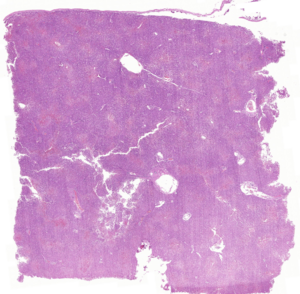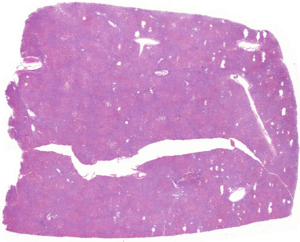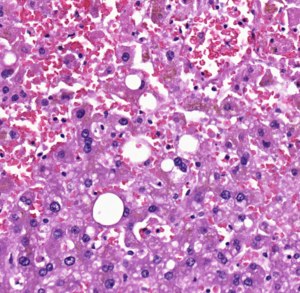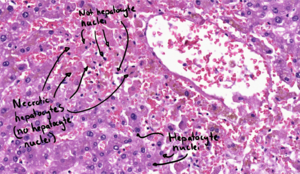21. Central haemorrhagic necrosis: Difference between revisions
(Created page with "'''Staining''': HE '''Organ''': Liver '''Description''': Many things can be seen here. Inside the sinusoidal spaces can RBCs be seen. Some hepatocytes have smaller, denser nuclei with vacuoles in their cytoplasm. Inside the portal triad can fibrosis be seen. In a few places can “fat bubbles” be seen. Lastly, around the central veins can necrosis be seen. Fewer nuclei are present and loss of structure can be seen. '''Diagnosis''': Central haemorrhagic liver necr...") |
(No difference)
|
Revision as of 10:22, 9 May 2022
Staining: HE
Organ: Liver
Description:
Many things can be seen here.
Inside the sinusoidal spaces can RBCs be seen. Some hepatocytes have smaller, denser nuclei with vacuoles in their cytoplasm. Inside the portal triad can fibrosis be seen. In a few places can “fat bubbles” be seen.
Lastly, around the central veins can necrosis be seen. Fewer nuclei are present and loss of structure can be seen.
Diagnosis: Central haemorrhagic liver necrosis
Causes:
- Chronic right ventricular failure + acute left ventricular failure
Theory:
Chronic right ventricular failure has a backward failure symptom called nutmeg liver or hepar moschatum. You can read about the mechanisms of backward failure in pathophysiology. The right-sided heart failure causes congestion of the venous system, which affects the liver. Recall from anatomy that the central vein is the vein that drains into the hepatic vein and eventually the inferior vena cava, while the veins in the portal triad originate from the portal vein. When the right ventricle fails will congestion occur in the inferior vena cava and therefore the central veins, but not the portal vein. The signs of congestion are therefore most prominent around the central vein.
The congestion in the liver causes RBCs to filter out from the vessels into the sinusoidal spaces. Fibrosis occurs around the portal triad, a process called incipient periportal fibrosis. Atrophy of hepatocytes occurs. Some fatty degeneration of the hepatocyte is also visible.
That was the case of nutmeg liver. Despite it not being in the topic list is it still possible to draw nutmeg liver as a slide on the exam! It’s similar to this slide in all ways except there is no necrosis around the central veins.
If a patient already has nutmeg liver and develops acute left ventricular failure will there be a haemorrhagic necrosis around the central veins, called central haemorrhagic liver necrosis. The necrosis occurs because of the hypoxia from the left ventricular failure, while the haemorrhage comes from the congestion from the right ventricular failure.







